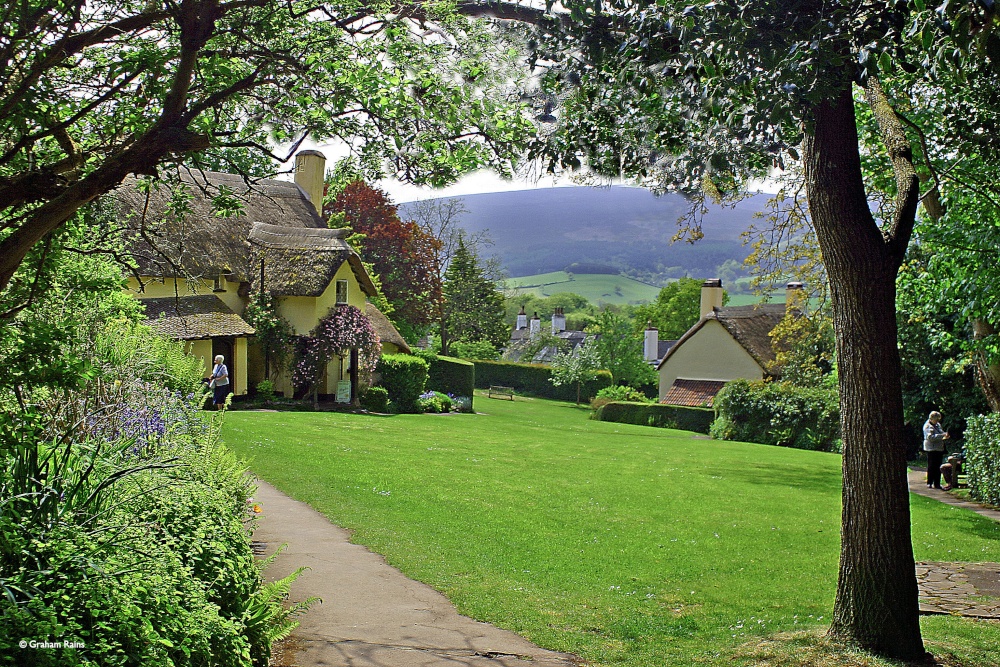
The edge of Exmoor - Image by PicturesOfEngland.com member Graham Rains (view gallery)
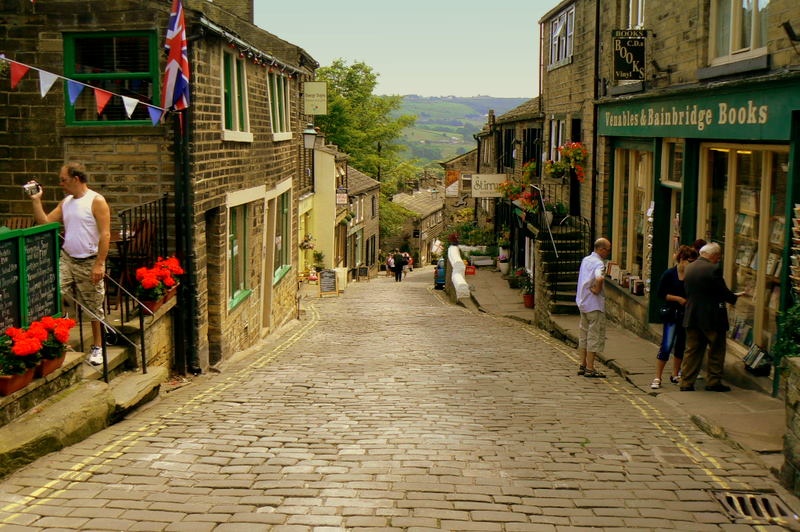
Lookin down! - Image by PicturesOfEngland.com member Christine Cooney (view gallery)
Haworth is famous the world over for its connections with the Bronte sisters, the famous novelists. They lived at Haworth Parsonage which is now a museum cared for and owned by the Bronte Society. This is where the bronte sisters once lived and wrote some of their most famous novels including Wuthering Heights, Jane Eyre and Agnes Grey. The village also hosts once a year a fantastic 1940's weekend.
ID#417

The Prettiest village in England . - Image by PicturesOfEngland.com member Bill Swan (view gallery)
Often cited as 'the most picturesque village in all of England', this award-winning place is one of the jewels in England's crown and one of the highlights of any visit to England. The village is situated on the southern edge of the Cotswolds, in a valley, and found its wealth in the wool trade with the villages picturesque river 'ByBrook' powering the mills. Visitors to the village can park at the top of the hill and wonder down into the village where they can enjoy walking round this lovely fairytale-like setting. Most buildings are made of the typical Cotswold limestone with its manor being built of the stone from the Norman castle that once sat above the village.
In its center is the 14th century Market Cross with old water pump beside it. The best view is said to be from by the old weavers cottage across the bridge.
The village has its own small museum containing local artifacts, old photos and maps, and a look at the history of the village and surrounding area.
ID#313
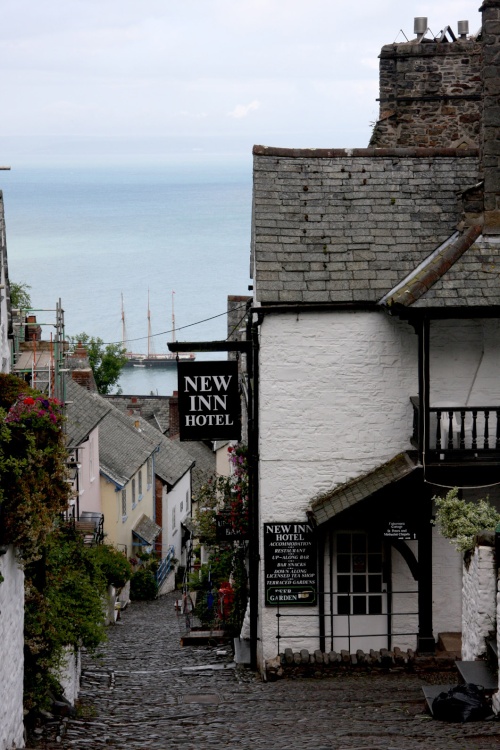
Clovelly High Street - Image by PicturesOfEngland.com member Suzy Harrison (view gallery)
Beautiful Clovelly, mentioned in the Doomsday book, has its origins rooted deep in Saxon times. Often referred to as Devons' Secret
Treasure, this lovely place has remained largely unchanged for centuries.
With its single cobbled street plunging in wide steps between quaint cottages to the sea some half a mile below, Clovelly is not for the feint hearted. To visit this, one of Englands' prized "Showplace" villages, the visitor needs plenty of stamina and comfy walking shoes for transport up and down the steep slopes is - on foot! Those who do decide to decend down the narrow slope are richly rewarded by the beguiling sight of flower decked cottages all tantalizingly different in shape, size and colour. The picture is very much of cottages tumbling over one another and at some of the steepest points, the door of one house looks out on the roof of its neighbour.
Once below, you are greeted by a small curving quay with an old inn facing the sheltered harbour estuary. The harbour is alive with pleasure boats and fishing craft, many of which provide locally caught crab and lobster to the cafes and inns that populate this pituresque village.
The Hamlyn family, Lords of the Manor, first occupied Clovelly Court in 1738 and much credit is due to this family for preserving the village and maintaining many of its cottages. Both house and village are now owned by a trust. At the top of a cliff close to this great house lies the church of All Saints which surprisingly has a Norman porch, a Jacobean pulpit and a monument to the novelist Charles Kingsley, author of Westward Ho, who lived in Clovelly as a child. The church and original court were built over 600 years ago. But the house was twice destroyed by fire and rebuilt - in the georgian era and in the 1940's when it was used as a convalescent home for Britains war wounded.
Many legends and customs still exist in these parts and on Shrove Tuesday, the village children drag tin cans and buckets up and down the cobbled streets. This action is said to scare off the Devil before Lent begins.
This area is a natural haunt for Devon's Artist community and there are many original paintings for sale in the local shops that are dotted up and down the main street and all around the harbour.
Clovelly is beautiful, it retains an 'Olde Worlde' charm that even along this breathtaking coastline, is simply incomparable.
ID#146

Thornton-le-Dale - Yorkshire Moors - Image by PicturesOfEngland.com member JauntyJane (view gallery)
Thornton-le-Dale is a lovely village lying at the foot of the North Yorkshire Moors. It offers visitors a choice of three pubs, a bistro, tea rooms, and excellent friendly village shops. The architecture of the village is typical of the area, with stone houses and cottages from Victorian times and beyond.
The regions outstanding attractions include the beautiful Yorkshire coast where you can discover Robin Hood's Bay and Whitby. The beautiful Dalby forest and the delightful market towns of Pickering, Malton, Kirkby and Helmsley.
Flamingoland offers an enjoyable visit for everyone as does the North Yorkshire Moors Railway which takes visitors on a romantic steam journey from Pickering through spectacular Newton Dale to Grossmont.
The area is superb for walking, forest drives and mountain hiking.
ID#9371
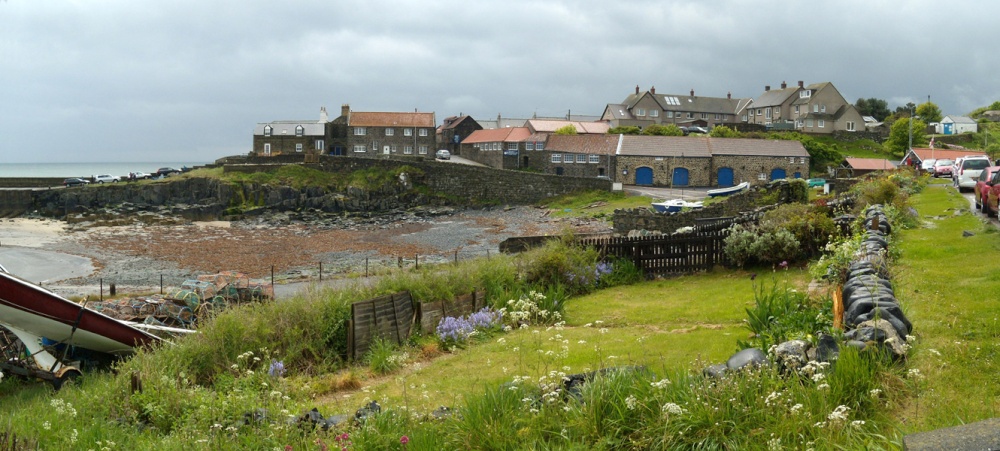
Craster Harbour - Image by PicturesOfEngland.com member Steve Willimott (view gallery)
Think of Craster and you immediately think of Kippers, delicious oak-smoked kippers are smoked in sheds above the harbour and these are a part of what this little place is famous for. The other is breathtaking cliff scenery
Craster is a quiet and unspoiled fishing village, the picturesque harbour though is no longer used for fishing, rather it is used by sailing crafts belonging to locals and holiday makers. Often the colourful sailing crafts jostle for position with the little cobles that go out looking for lobster and crabs. The shortage of Herrings means that few are caught in these waters and these days Herrings for kippering and smoking are delivered from Scotland.
Typically, the houses and cottages here are built of stone, some are quite ancient and have the appearance of growing out from the hard rock on which they stand, they are gaunt and strong, built to withstand the harsh weather and howling gales that pound this magnificent coastline. To enjoy this fine scenery at it's best you should walk the boulder strewn path to Dunstanburgh Castle. Here, a rocky promontory juts out into the sea, it is magnificently crowned with the romantic ruins of the 14th-century castle, there is an unreal quality here, a rare and matchless beauty.
There are several places of interest in both Craster and the surrounding regions; above the village is Craster Tower, a Georgian house which incorporates the remains of an earlier building of medieval origins. Howick Hall is at nearby Howick and there are two fine golf courses and an ancient Battle site at Stamford.
You can have a fine time in this very pretty and hospitable little fishing village and there are plenty of cafe's and inns in which to taste the famous kippers, they are so delicious you will surely take some home with you - enjoy!
ID#365
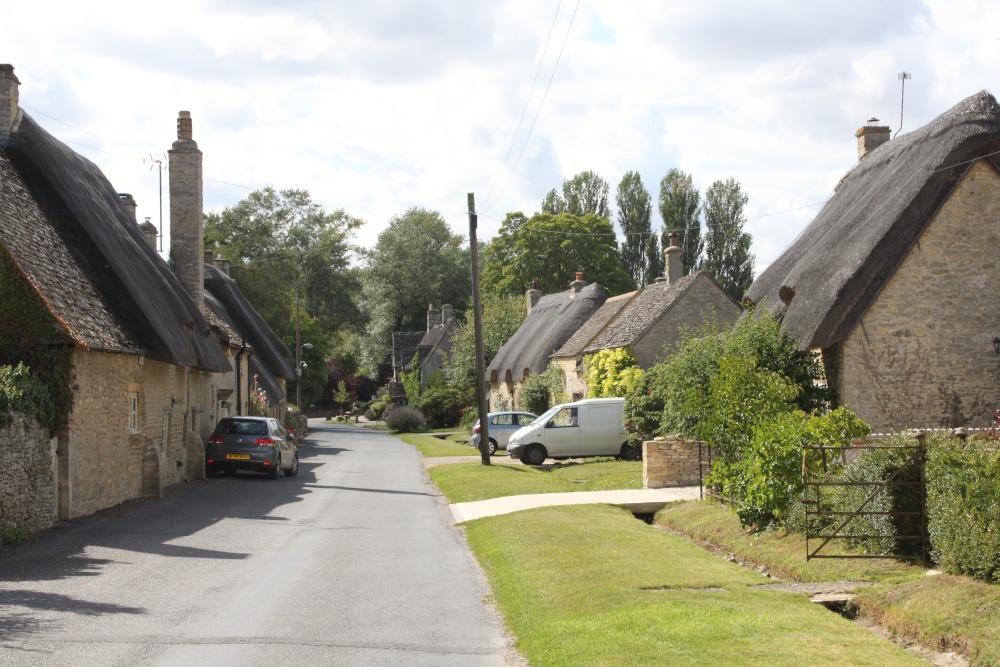
Cottages in Old Minster, Minster Lovell - Image by PicturesOfEngland.com member Roger Sweet (view gallery)
This village is renowned as one of the loveliest villages along the Windrush valley. It has all the attributes of the perfect English village, including legends of centuries ago. Francis Lovell, a member of the powerful Lovell family of Minster Lovell Hall, supported the 15th-century pretender Lambert Simnel. He hid in a secret room which was known only to one servant, the servant died suddenly, leaving Lovell unable to get out, and to eventually die of starvation. In the early part of the 18th-century, during alterations to the Hall, the skeleton of a man was discovered in a concealed room - thus according to many, it was the body of Francis Lovell, and the legend was confirmed.
Minster Lovell, in its beautiful dream-like setting against the gently rising Cotswold landscape, has a history stretching back to Saxon times. It has a five hundred year old bridge spanning the meandering Windrush, attractive cottage properties, and the spectacular 15th-century ruins of a once great house, home of the Lovell's, which was visited by Henry VII on no less than three occasions. Minster Lovell has beautiful mellow Cotswold stone houses and inns - The Mill and Old Swan is a fine example, it stands in the midst of a lovely estate on the banks of the river, where it has stood for over 600 years.
The Minster Lovell experience is not to be missed. It is a small intimate museum in the private home of artist, Graham Kew. The museum is on the outskirts of the village where Graham Kew, a gifted story-teller, strives to keep alive the many romantic legends of Minster Lovell's past.
If you are seeking peace and quite mixed with a bit of history and a dash of sweet enchantment then Minster Lovell is the perfect place for you. You can wander its quite lanes, picnic at the side of crystal clear waters, spend a few moments of quiet reflection amid the beauty of the historic walls of St.Kenelms church or, just joyfully amble around soaking up a tranquil atmosphere, hard to find in any other place.
Minster Lovell is close to several charming Cotswold villages, and the market towns of Burford, Chipping Norton, Witney and Woodstock lie within easy driving distance.
ID#24506

Polperro in Cornwall - Image by PicturesOfEngland.com member JauntyJane (view gallery)
Jagged rocks rise as if to guard the entrance to the picturesque harbour of this enchanting fishing village which has for decades been a magnet for tourists and a mecca for artists from all over England. A charming mixture of quaint whitewashed cottages with brightly painted doors and windows, interspersed here and there with more substantial buildings, cram the steep hills and narrow streets that form the backdrop to the harbour. Heading from the sea, towards the shore, the picture that greets the eye, would be hard to equal anywhere.
Famous as a fishing village, this little place, in the 19th-century was the haunt of smugglers and it would seem that fishing and smuggling provided the main income for most families. These days not so much fishing goes on and in the summer the little harbour is full of gaily coloured yachts and pleasure boats.
A famous resident of Polperro was Dr. Johnathon Couch. Dr. Couch wrote four volumes on the History of the Fishes of the British Isles in the 1860's. At the same time he managed to continue with his medical practise and care for his patients. When he died his house became a museum.
Rugged coastal scenery can be enjoyed throughout this region. The walks along the south west coast path reward the visitor with spectacular views of coastal scenery and the sea. Inland, a short distance from Polperro is a model village and just a few miles from Looe is a famous Monkey Sanctury. There is a host of galleries, antique shops, pleasant cafe's and picturesque inns. The pace of life is refreshingly relaxed and enjoyable and it is easy to see why so many of Polperro's visitors return time and time again.
ID#367

Another little alleyway - Image by PicturesOfEngland.com member Dave John (view gallery)
The talk in the local pub is all of Robin Hood, did he pass through this bay whilst journeying to Whitby, or did he not? the considered opinion seems to be that any connection between the outlaw and this beautiful bay is rather dubious. That being said, one does though, continue to ponder the possibility for this little place is alive with myths and legends of the smuggling trade that flourished here in the 18th-century.
The pretty village seemingly tumbles down the main cobbled street and finishes up where the sea laps the shore. Little cottages, mostly of stone with bright red roofs, some three storey's high, cling precariously to the cliffs upon which this village is built. It is a charming place and the little alleyways and terraces do indeed evoke images of smuggling. Legend has it that a tunnel through which King's Beck discharges into the sea was used by smugglers, and that other tunnel's branch from it in a network that runs beneath most of the village.
This is one of the richest stretches of coast for fossils in England, low tide exposes a sea bed full of tide and rock pools which offer wonderful examples such as the oyster-like Liostrea and coiled ammonites - known in these parts as St.Hilda's Serpents. The oldest rocks about here are said to date from the Jurasic Period.
A walk across the bay to nearby Ravenscar at low tide can be richly rewarding. The scenery all around is nothing less than spectacular, especially when the waves are tinged bright copper by a golden, setting sun. There is though, a continuing battle between land and sea and raging storms have claimed many buildings. Over the years, many cottages and great chunks of cliff have been lost to the sea and this has caused the building of a huge rock sea wall to protect the village.
The village offers quaint shops, cafes and excellent old inns and pubs. Beware though, the road down into the village thrusts deep and twists at sharp angles. Thoughtfully, handrails have been provided to help the visitor navigate the steeply stepped street. They are well used by locals and all who visit this beautiful bay. Oh, and by the way, if you are lucky, you just might catch a glimpse of Robin Hood on his way to Whitby!
Attractions in the area include the North Yorkshire Moors Railway, Wheeldale Roman Road and the Newtondale Forest Drive.
ID#361

The edge of Exmoor - Image by PicturesOfEngland.com member Graham Rains (view gallery)
Blessed with a wealth of superb thatched cottages and a beautiful old church, Selworthy Green is the very epitome of an English country village. It occupies a magnificent setting in the Exmoor National Park and is but a short distance from Minehead Bluff on the famous South West Coast Path.
This 'jewel of a village' is not as ancient as it first appears. It was in fact built as late as 1828 when, on a whim the old Selworthy was pulled down by Sir Thomas Acland of Killerton, who decided to rebuild with suitable housing to meet the needs of the elderly folk living on the Holnicote estate. It was his intension that the buildings should be sympathetically designed, retaining the charm and atmosphere of a bye-gone era - this Sir Thomas did in full measure and using only traditional materials he created a place of rare enchantment that is in perfect harmony with the 15th-century church of All Saints. The church alone is well worth a visit, it's pulpit has a 17th-century hour glass and the iron-bound parish chest is of the same period. The church tower dates from the 14th-century and the roof is a cherished example of fine wood carving.
Selworthy Green is the start of a picturesque walk through steep woodlands to the gorse-gold and heather clad summit of Selworthy Beacon from which there are magnificent views over the undulating countryside, taking in Dunkerry Hill which at 1705 is the highest point on Exmoor.
If deep thatched cottages with curved thick eyebrow dormers to which rich foliage clings, are for you, then this peaceful village is not to be missed.
Places to visit include: Porlock Bay, Dunkerry Hill, Dunster Castle, Minehead and Dulverton.
ID#29158
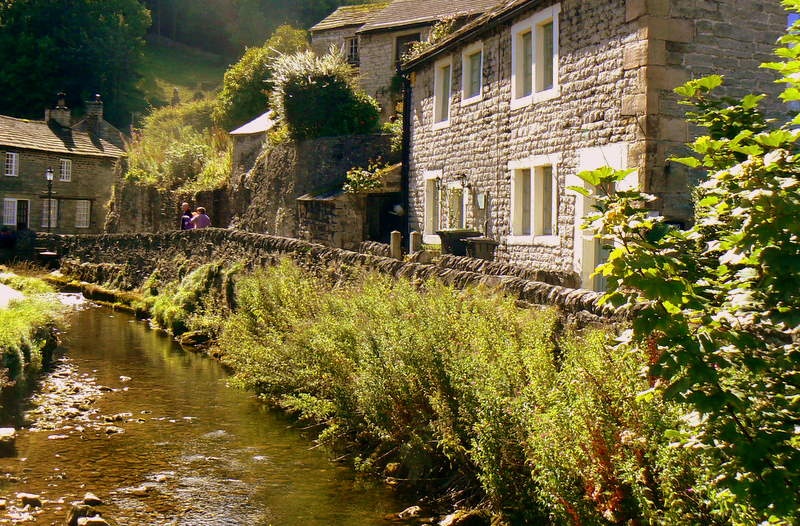
Village stream - Image by PicturesOfEngland.com member Christine Cooney (view gallery)
Castleton is one of the Jewels of the Peak District. It is a famous centre for caverns where you will find four of the countries most famous show caves. It is also the home of the ruined Peveril Castle, built in Norman times and immortalized forever in Sir Walter Scott's - Peveril of the Peak.
This is limestone country where the grandeur of the peaks is matched by the sheer brilliance to be discovered under-ground. Two caverns are both in Treak Cliff, these are beautiful places where floodlighting highlights the strange rock formations, the stalagmites, stalactites and the arch of Blue John stone. In the Blue John cavern there are spacious chambers and connecting passages running into the hills. Here you will find the famous stone in its natural setting, and gaze in wonder you might, for this glorious blue stone is found in no other place on earth. Fine pieces of Blue John have found their way to some historic places, it is believed to have been displayed in the Vatican Library in Rome, and good specimens can be seen in Chatsworth House and at Ashbourne parish church, both lie within the Peaks.
Peak Cavern, Devil's Cavern, and Speedwell Cavern are all equally impressive, with Speedwell lying beneath a spectacular ravine called the Winnats, found just to the west of the town.
Just as in the Spring Castleton celebrates Oak Apple Day, or Garland Day as it was once known, each Christmas the town hosts seasonal events in its famous caverns; Carols by Candlelight is held at Treak Cliff Cavern, and at Peak Cavern there is carol singing and a brass band.
The town's parish church is of Norman foundation and is dedicated to St.Edmund. The church we see today was largely rebuilt in 1837 with only the chancel arch remaining from the earlier church. The church tower has battlements and eight pinnacles, and inside you can see fine box pews, some inscribed with 17th-century dates.
The hope valley is highly picturesque with breath-taking scenery in every direction. Mam Tor, looms high over the village, this is thought to be where the Celts settled, there are the remains of a Celtic Hillfort at the summit in an enclosure of 16 acres. Here the altitude is around 1700ft.
For walkers this place is idyllic, a myriad of footpaths lead from Castleton taking you deep into the countryside, giving splendid views of lofty peaks and gentle river valley's. In Castleton itself there is a rich array of beautiful limestone buildings, including pubs. One of these, the Castleton Hotel dates 17th-century, as does the former Castleton Hall which is now a Youth Hostel.
Jubilant celebrations in Castleton commemorate the restoration of Charles II. On 29th May each year a group of Morris Dancers led by a King and Queen accompanied by a band parade through the streets of the town to the Market Place. The King is covered in flowers, and everyone dances as they celebrate the restoration of the Monarch, and the coming of Spring.
Castleton offers visitors a wealth of interest, it has well stocked local shops, gift and galleries, a splendid range of accommodation for those wishing to stay and explore, or it makes a lovely destination for a pleasant day out - but beware, stout walking shoes are essential!
ID#124
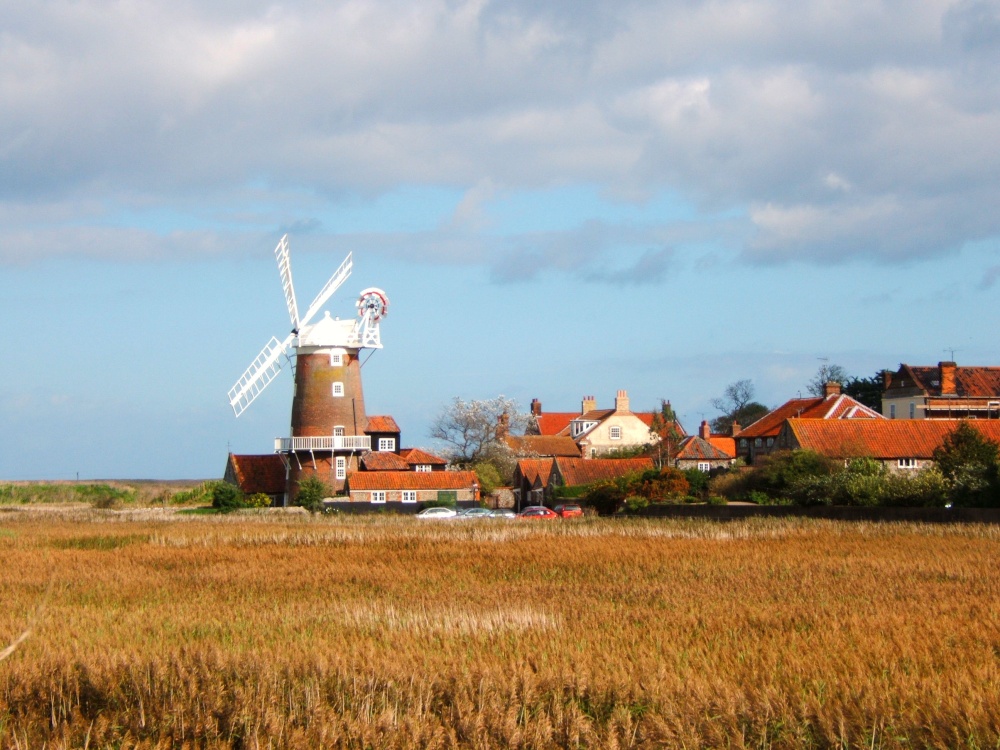
Cley Mill - Image by PicturesOfEngland.com member Martin Thirkettle (view gallery)
ID#15218
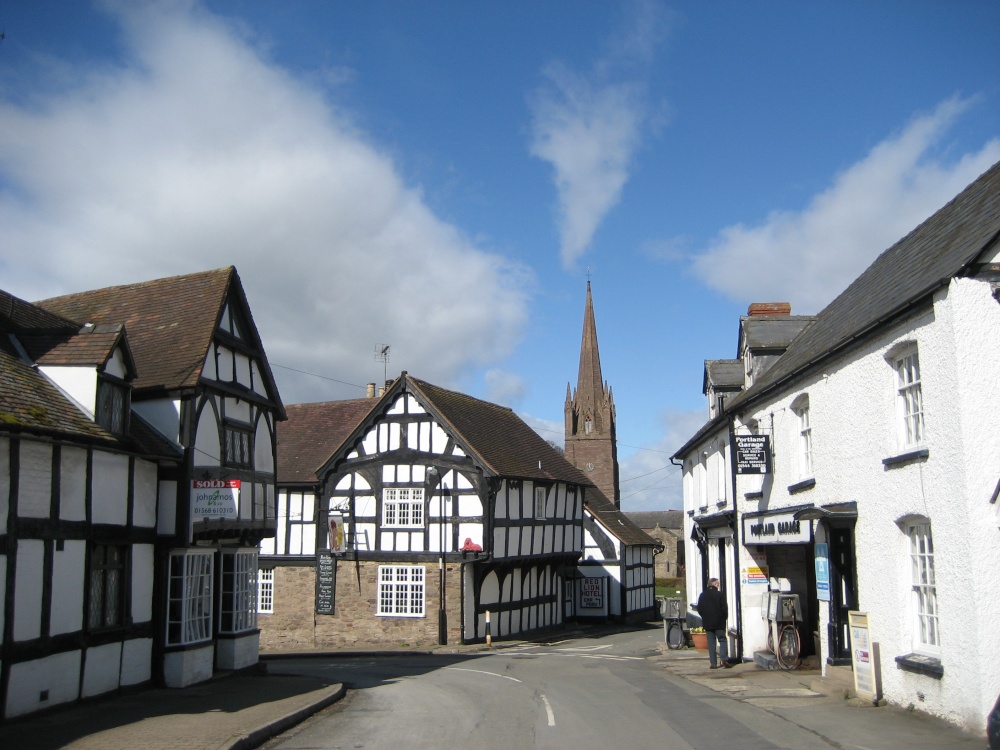
Weobley - Image by PicturesOfEngland.com member rady38 (view gallery)
Charming, black and white half timbered village with an old fashioned Christmas card appeal. It has many old buildings from past centuries, chief of these is the church of the 13th century with its lofty spire, and the Red Lion Inn from the 14th century.
This is one of a threadwork of similar attractive Herefordshire villages, but it is by far the most unspoilt, with leafy lanes leading into the rich apple orchards of the dreamy Herefordshire countryside.
ID#21382
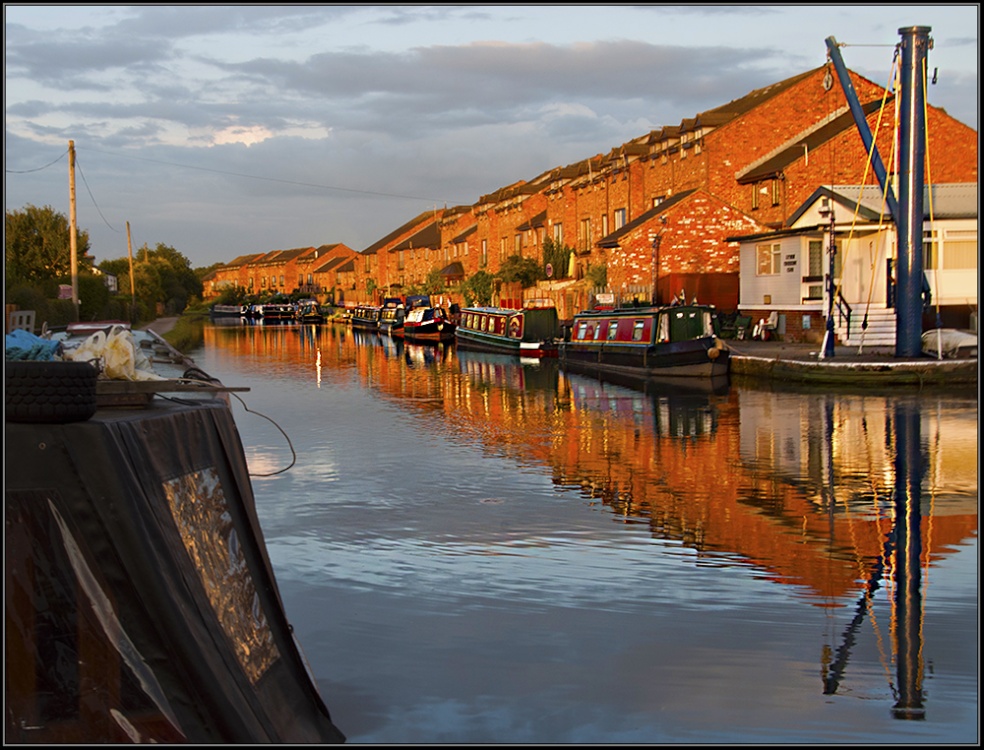
Sunset Glow. - Image by PicturesOfEngland.com member Patrick Hogan (view gallery)
The picturesque village of Lymm is situated in the the county of Cheshire, England, and was mentioned in the Doomsday book of 1086. It's name is of Celtic origins and means "Place of running water" probably derived from an ancient stream that ran through the center of the village, as today does the Bridgewater canal which was an important transportation link during the 19th century. The village of Lymm is a designated conservation area which is noted for its many historic buildings such as the French style terracotta former town hall, its listed churches such as St Peter's church, and St Mary's Church which overlooks Lymm Dam. Lymm Cross is a Grade I listed structure dating from the 17th century, next to which stand the village stocks which are Grade II listed.
ID#12792
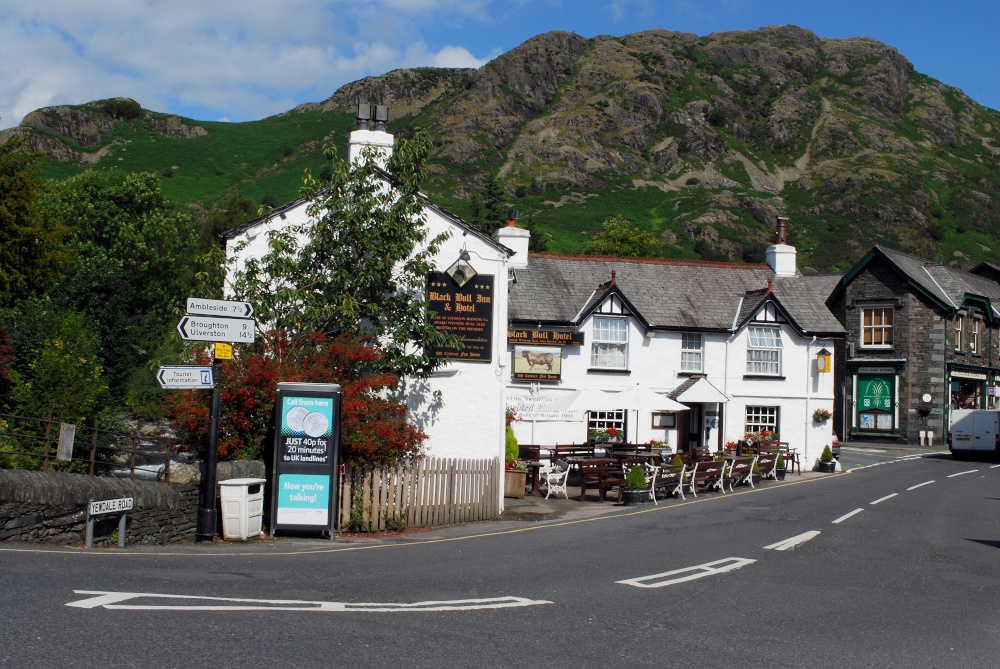
Black Bull Inn - Image by PicturesOfEngland.com member Ray Hutcheon (view gallery)
There is a timelessness about this pretty village which is set beneath the awesome splendour of "The Old Man of Coniston" towering some 2,500ft above.
The properties in the village, though not of great age are attractive and charming. Some are built from the dark local stone and others have walls that glisten with whitewash. Of the architectual features to be found in Coniston, perhaps the most handsome is a whitewashed, seven doorway terrace, right beneath the Old Man and overlooking the Church Beck's boulder-strewn waters. This terrace is said to be about 165 years old.
Apart from the infinite beauty of Coniston Water, it will be long remembered as the place where Donald Campbell died while trying to break the world water-speed record in 1967. His jet-powered Blue-Bird lost control at more than 300 m.p.h. and it is only recently that Donald Campbell's body was recovered.
Of the historic features - nearby the main street a museum pays tribute to the life and celebrated work of John Ruskin, the victorian writer, critic and social reformer. Ruskin had a profound influence on the general artistic taste of his time and he lived at his home on the far side of Coniston Water from 1871 until his death in 1900. Given the great honour of a grave in Westminster Abbey, he chose instead to buried in a quiet corner of the local churchyard and lies beneath a beautifully carved wooden cross.
Interestingly, this beautiful place was chosen by Arthur Ransome as the setting for his world famous novel Swallows and Amazons.
Coniston and the surrounding lakeland area is popular with anglers, fell walkers and climbers. People converge here for a variety of reasons at all times of the year. In the summer when the sun shines and the land is fresh and green, the beautiful scenery of the lakes is best enjoyed from the water. In the autumn and winter months, with snow clinging to the peak of The Old Man and water cascading down ridges in a series of endless waterfalls, it is then, that this picturesque place comes into its own. The dark waters of Coniston, spread out on the valley floor beneath the snow covered mountainous Old Man in a setting of unrivalled beauty is indeed Lakeland's "Jewel in the Crown" it is no wonder that this special place has long remained the haunt of many celebrated Artists.
Other lakes in the area are, Windermere, Wast Water and to the north of this great area lies Bassenthwaite Lake, Ullswater and Derwent Water. There are many enchanting towns and villages and a host of genial inns and pubs. There are a great many shops all well stocked with the requirements of modern living to locally made souvenirs.
ID#242
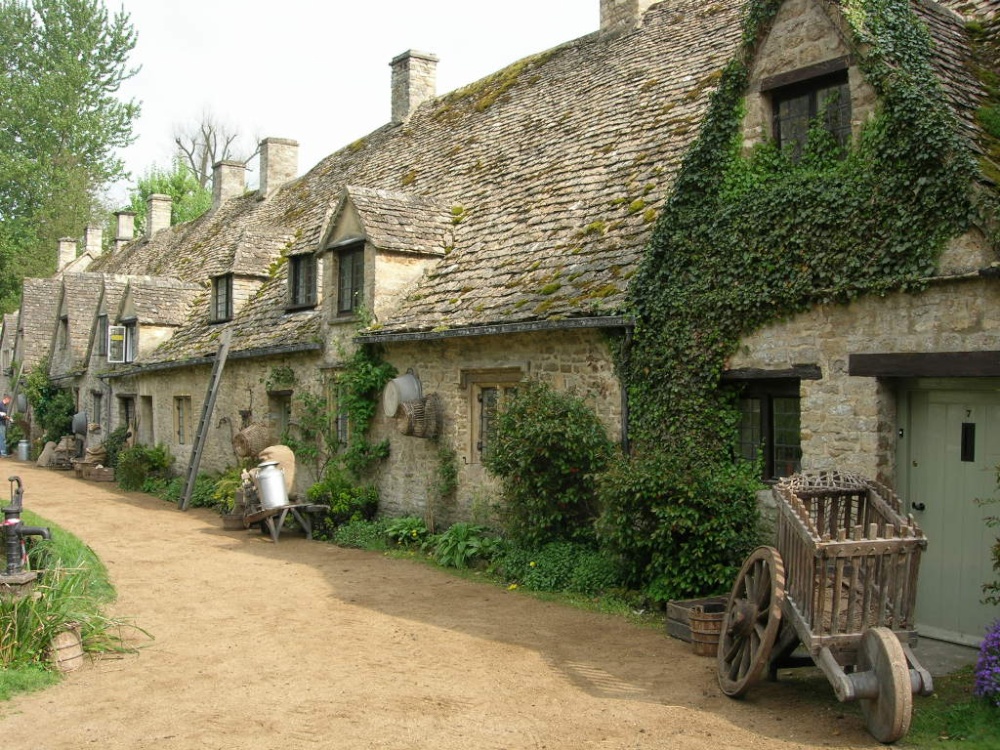
Arlington Row - Image by PicturesOfEngland.com member Charmaine Mcinnis (view gallery)
William Morris, the 19th-century artist and poet thought Bibury to be the most beautiful village in England. This sentiment was echoed by another Victorian, J. Arthur Gibbs, wrote of it elequently in A Cotswold Village, published in 1898.
The slow moving River Coln wends its way between wooded banks and is spanned by a road bridge dated 1790. Many of the stone-built houses have gardens than run down to meet this sparkling river, and on the banks of the mill stream which flows into the Coln, stands a terrace of gabled and stone-tiled cottages called Arlington Row. The cottages were converted from a 14th-century sheephouse in the early 17th-century to provide housing for weavers supplying cloth for the nearby Arlington Mill. These cottages are now owned by the National Trust and Arlington Mill is now a museum and houses a fine collection of furniture from the Cotswold Arts and Crafts movement.
There is a rich variance of properties in Bibury, some are of timber frame with thatched roofs, but mostly they are built of Honey coloured Cotswold stone, having steep gables and tall chimneys, often with delightful small stone clad windows and nearly all submerged in seemingly motionless green foilage. It is these wonderful houses, so traditional of the Cotswolds, that causes Bibury to be thronged with an endless stream of visitors throughout, not only high summer but all the year round.
The centre of Bibury is the square, overlooked by the Saxon Church of St. Mary. St. Mary's has many later additions, mostly Norman and Medieval, but much of the Saxon work is still visible.
Bibury Court is of Jacobean origin and The Swan is a pleasant early coaching inn. There are several other inns and public houses
both in and around the village.
This is an enchanting village and well worth a visit for it is a village that possesses the dream-like quality of a Christmas card.
For further information, please visit: www.bibury.com
ID#296
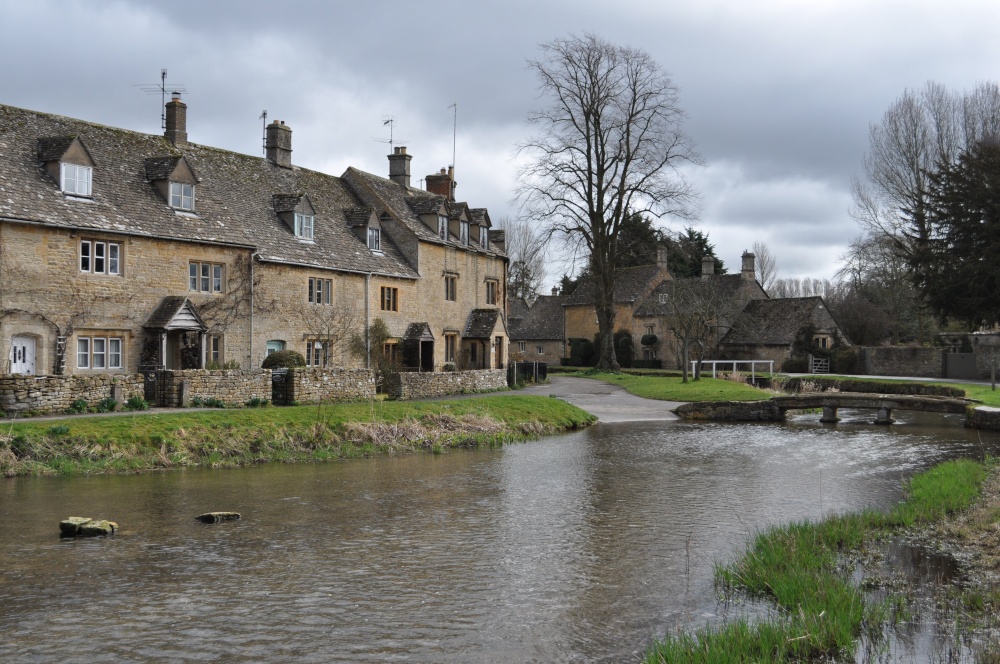
Lower Slaughter - Image by PicturesOfEngland.com member Jez Taylor (view gallery)
Lower Slaughter is one of the Cotswold's most idyllic villages where you should abandon your car and roam around on foot. It perfectly epitomises the very best of tranquil English villages, having the notable attributes of peaceful flowing waters, a lovely old mill, gorgeous stone cottages, a splendid church and two beautiful 17th century country houses now converted into luxurious country house hotels.
The gentle waters of the River Eye flow slowly beneath narrow footbridges. The Old Mill, with its restored water-wheel acts as a magnet to visitors, it has undergone recent refurbishment and offers a museum, craft shop and tea-room.
Perhaps the most notable feature of the village is its lovely church dedicated to St.Mary. Here, on a walk around the church visitors gaze in wonder at its ancient spire, rich adornments to its beautiful stone walls, and inside you are bewitched by the dazzling rays of light falling through stunning stained glass windows. There are glorious carved stone arches, glowing woodwork, a memorable font, and many other church treasures in this peaceful place which is worth looking around and spending a few moments in quiet contemplation.
Lower Slaughter Manor is Grade II listed, it is now a hotel set in beautiful grounds where you will find an attractive walled garden. Washbourne Court is set at the side of the River Eye, this too is now a hotel. Both these wonderful old places typify the gracious, romantic era in which they were first built over 300 years ago. Like the rest of the village, these buildings look gorgeous when dappled by the fading light of a setting sun.
ID#70
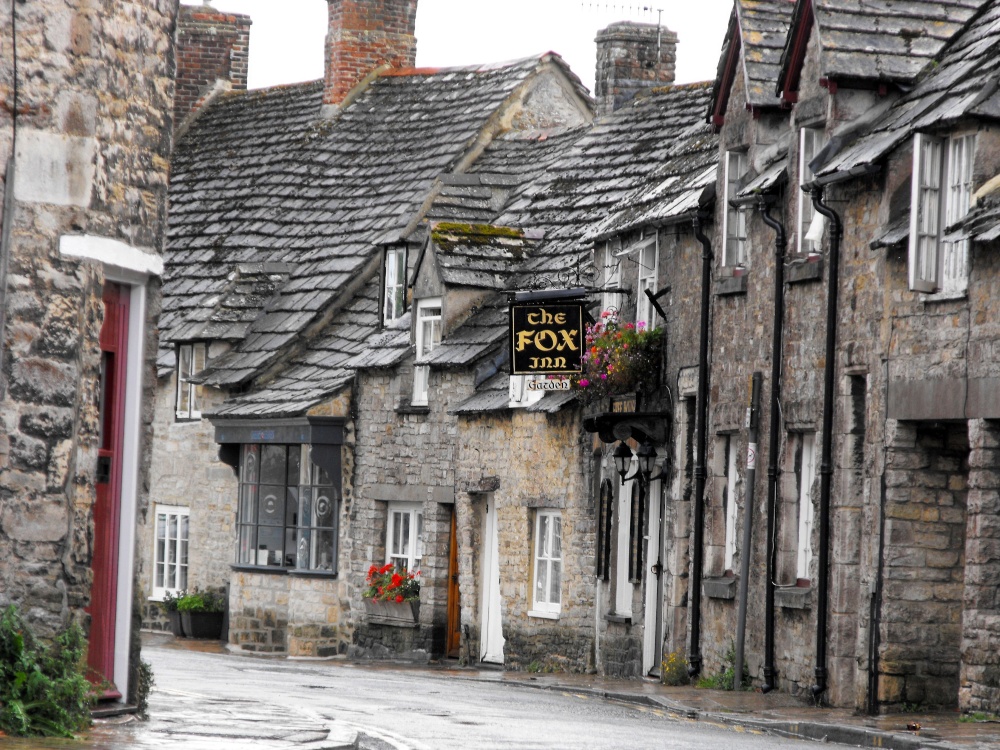
You don't get much more English than this..... - Image by PicturesOfEngland.com member Ruth Gregory (view gallery)
Standing in lofty splendour above the chimney pots of the village with the roaring ocean lapping the cliffs to the other side of a rocky outcrop, the romantic ruins of medieval Corfe Castle, cast a dramatic shadow from every approach. There is evidence of habitation in the area in the days of pre-history but Corfe really came to prominence when the great castle was begun at the time of William the Conqueror.
The castle has a stirring history, and although for nearly all of the medieval period it was a Royal residence, it was tainted by dark and secretive deeds. King Edward II was imprisoned here and strangely, King John kept his crown jewels at Corfe. When the throne passed to Henry VII he gave the castle to his mother, however when Henry VIII succeeded, he claimed the castle for himself. Henry's daughter Queen Elizabeth I, sold Corfe to Sir Christopher Hatton, a favourite courtier and Chancellor. He fortified it as part of England's defences against the Spanish Armada.
Corfe Castle was eventually sold by the Hatton family, and at the time of the Civil War it was owned by the powerful Bankes family. Sir John Bankes was Lord Chief Justice to Charles I. Again mischief was afoot, Lady Bankes stood alone and in spite of holding the castle through the sieges of 1643 and 1645, she was finally brought down by the treachery of Colonel Pitman, one of her own officers.
The castle was left in ruins by the Parliamentarian forces, and although it continued in the ownership of the Bankes family it remained derelict throughout the centuries until it was gifted by the Bankes's to the National Trust in 1982.
Below the castle, the village of Corfe shows picturesque stone houses of the 17th-century. At the Corfe Castle Model Village you can see a perfect replica of the once mighty fortress. It's former splendour is vividly portrayed and like the magnificent hilltop ruin, cannot fail to impress all who see it.
ID#33266
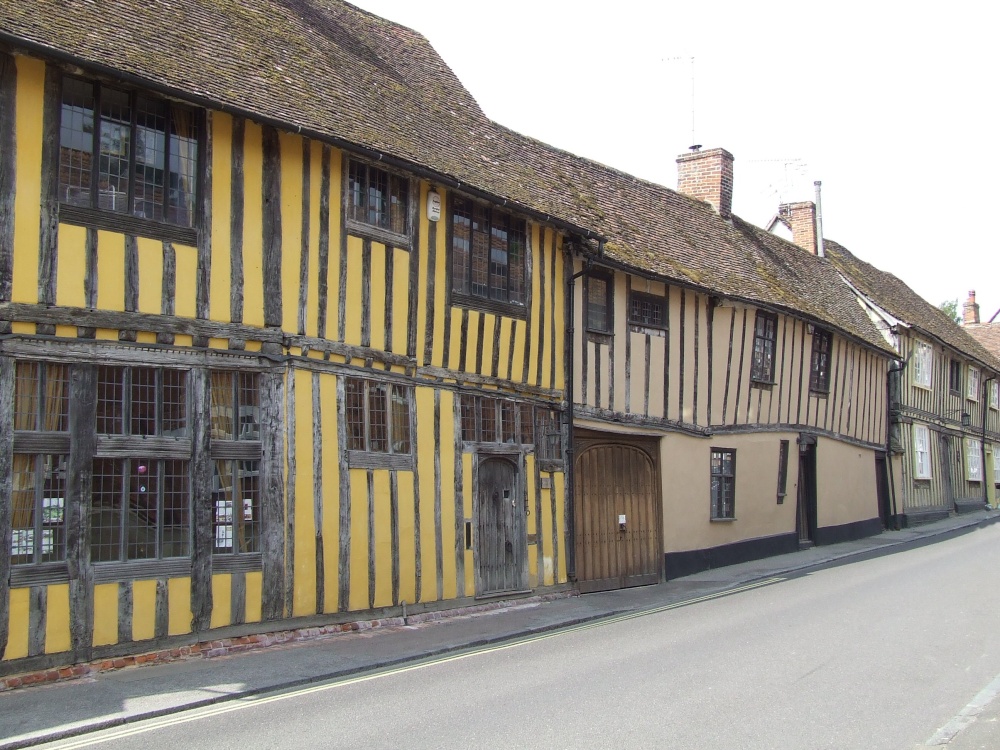
Lavenham - Image by PicturesOfEngland.com member Thomas Crossley (view gallery)
Considered to be Britain's best preserved medieval village, Lavenham, with its wonderful clusters of fine Tudor houses offering the visitor a glimpse of just how a prosperous wool settlement must have looked during its' hey-day in the middle ages. The wealthy merchants of Lavenham and the wool trade have long since gone but still exists these grand old houses, churches and other beautiful buildings that have stood the test of time and bear witness to the towns enduring prosperity.
Justly proud of thier heritage are the local residents that Lavenham's telegraph poles were removed from view in 1967 and the lines hidden underground. Thus, the Market Place which dates back to the 13th century, looks today, very much as it did in medieval times.
The Guildhall which is known for being one of the finest Tudor half-timbered buildings in the country, is now a museum displaying objects of local historic interest.
To this day several old streets exist and still bear thier original names. Water Street, so named because a river ran alongside it. Shilling Street has nothing to do with money but derives from Schyling, who was a Flemish weaver who came here to teach his english counterparts how to best make cloth. It is known that this street was lived in by Isaac Taylor, engraver and author whose daughter penned the rhyme Twinkle, Twinkle, little star.
There are many old well preserved weavers cottages to be seen and some still have the original craft symbols in their plasterwork, including one to the patron saint of cloth workers, Saint Blaise.
In the old part of the Swan Hotel a preserved section of the old bar wall is covered with the signatures of American Airmen of the 487th Bomb Group. These men were based locally during the second world war.
The church of Saint Peter and Saint Paul is reputed to be the greatest of all the "Wood Churches" in East Anglia and owes it's magnificence mostly to the 13th Earl of Oxford and the family of the rich clothier Thomas Sprying who, together with other wealthy folk gave generously to the church in thanksgiving for the end of the Wars of the Roses in 1485.
As one would expect from a prosperous and enterprising village, the visitor will find a wealth of historic inns, beguiling gift shops, art and antique shops, all of which are too tempting to resist.
ID#228
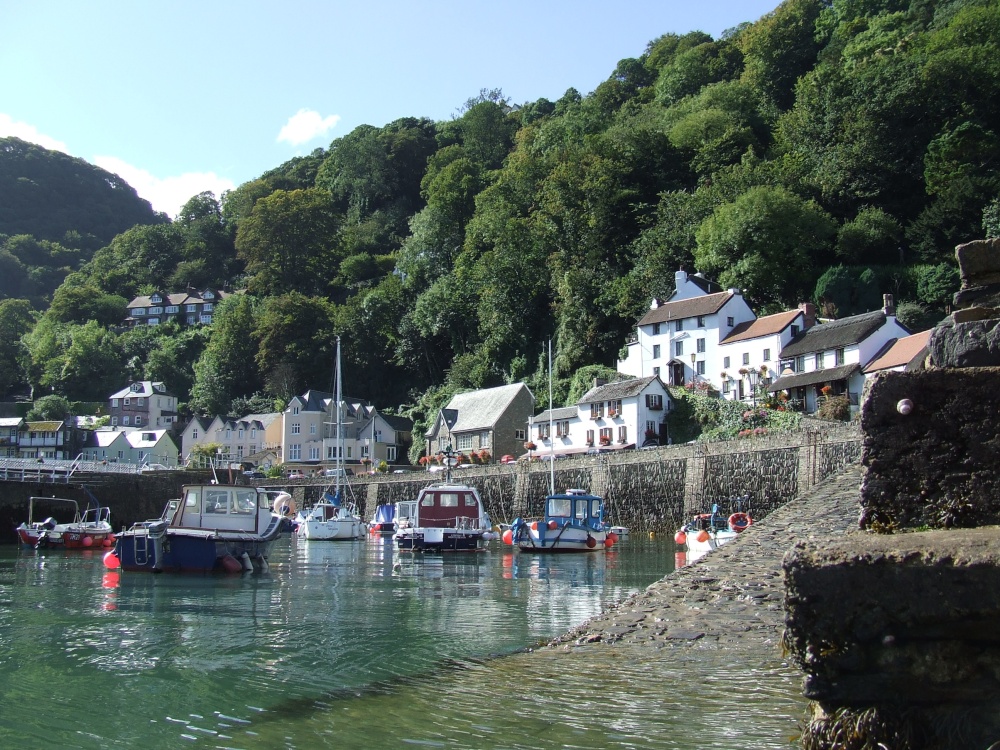
Lynmouth Harbour - Image by PicturesOfEngland.com member Tim Mariner (view gallery)
This is the place where Percy Bysshe Shelley, and his sixteen year old bride, Mary Wollstonecraft, spent the first nine weeks of their married life. Here, in 1812, in what was then a small picturesque fishing village they sought refuge from the wrath of Mary's outraged parents, it is this that brought early 19th century media interest and soon word of the dramatic rugged scenery was spreading. The area was visited by Wordsworth, Coleridge and Southey, it very quickly became one of Devon's most popular beauty spots and remains so to this day.
In Lynmouth visitors can experience the thrill of a memorable ride on the cliff railway. This was installed in 1890 with money donated by Sir George Newness, who also built Lynton's Town Hall in honour of his son's 21st birthday, it climbs over 500 feet, taking visitors from the beach to the town above. The town retains much of the charm of the old village, it has quaint cottages, some with thatch, handsome Victorian and Georgian properties and the meandering River Lyn scampers over small boulders and stones weaving its way through the lower reaches of town to the sea.
The drama of this coast is sublime, Lynmouth is reached by a 1 in 4 road and the views are some of the most magical in the whole of Devon. Away from the coast the spectacular scenery continues with a fascinating gorge, waterfall and fountain. There is also a wonderful scenic Tea Garden run by the national Trust.
On the other side of the River Lyn lies Lynton and the famous Valley of the Rocks. However, this is no area for the feint hearted as the best views are to be had from walks up hill.
Today, Lynmouth is one of North Devon's most popular holiday destinations. It is lively, with plenty of shops, inns, hotels and visitor attractions. It offers easy access to the Exmoor National Park, is close to the 991 foot high cliffs of Countisbury Common, the lighthouse at Foreland Point, and the picturesque spot called Watersmeet where the East Lyn River and the Hoaroak Water join.
ID#28996
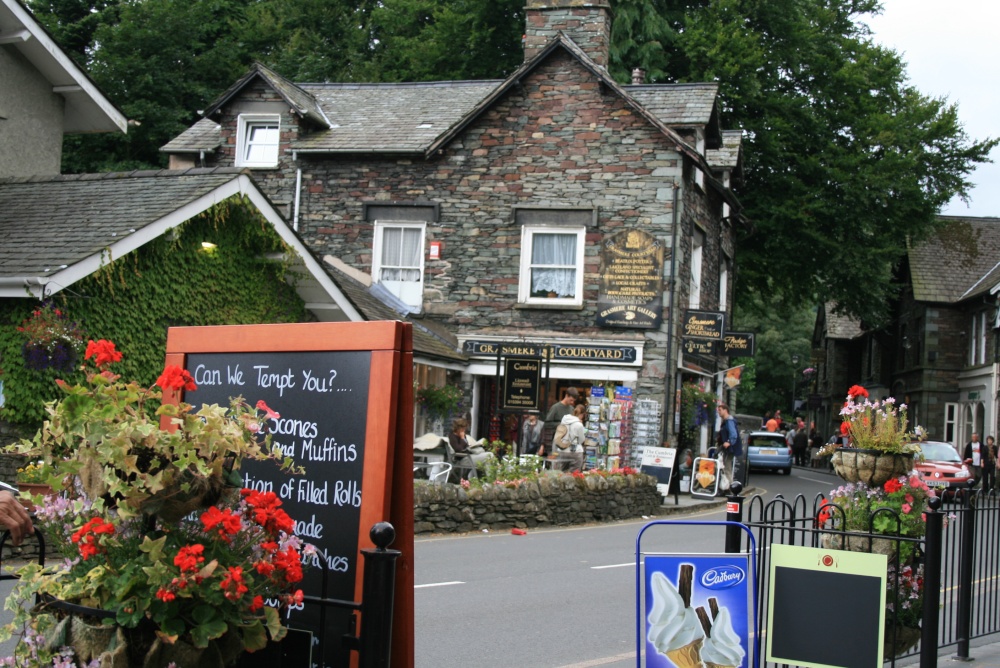
Grasmere - Image by PicturesOfEngland.com member Graeme Dormer (view gallery)
This tiny stone village is beautifully set between the tranquil waters of Grasmere Lake and the jagged heights of Helm Crag and Nab Scar. Close-by is a beautiful natural arena where the famous Grasmere Sports are staged each August, this event perpetuates many Lakeland traditions. Local sheepdog trials are held in the village at around the same time.
The village and its valley are seen at their best from the surrounding hills To the left of the village is the Swan Hotel and it is reputed that Sir Walter Scott had breakfast here whilst staying with the celebrated poet Wordsworth. Born in 1770, William Wordsworth died at his home Rydal Mount in the year 1850 a few days after his 80th birthday. His years here were happy and productive, he must have drawn much inspiration from the beauty and tranquility of this spectacular Lakeland area.
William and his devoted sister Dorothy, lived in a delightful stone cottage situated beyond the village church where a lane skirts the fields before reaching Town End and a pretty cluster of stone slate roofed cottages with glorious westward views. They moved together into Dove Cottage, originally an inn called the Dove and Olive Bough for which they paid an annual rent of £8.00. In the year 1782 the poet married Mary Hutchinson, and three of their children were born at Dove Cottage during the following four years.
In 1808, the Wordsworth’s moved to Allan Bank and the cottage became the home of their friend Thomas de Quincey, author of The Confessions of an English Opium Eater.
The Wordsworth Museum, a short distance from Dove Cottage, contains many of Wordsworth's personal possessions and there is also a reconstruction of a typical farmhouse kitchen.
Allan Bank, where the Wordsworth’s lived until 1811 is not open to visitors. The poet and his family spent the next two years at the Rectory opposite the Church of St. Oswald before moving to Rydal Mount which is situate on the road between Grasmere and Ambleside where the great man was to spend the rest of his life.
There are many pleasant building in and around Grasmere and just past the Swan Hotel, at a point close to the River Rothay an old creeper covered house stands by the bridge. It is perhaps one of the most attractive houses in the village. Grey-green and purple tinged stone shops, houses and cottages flank Broad Street which has a pleasant little green at it's junction with College Street. Several hotels are clustered in the heart of Grasmere, before the main road reaches the Church on the bank of the Rothay. The small building by the lych gate was the village school from 1660 until 1854.
William Wordsworth knew the village church of St. Oswald well, he described it in his epic poem, The Excursion, thus it is immortalised forever. In the church near the alter, an inscribed profile in white marble depicts Wordsworth between graceful daffodils and bluebells.
Every year on a Sunday nearest to 5th August, St. Oswalds day, a colourful, rush bearing procession wends its way through Grasmere to the church. The ancient ceremony, kept alive in Grasmere and a few other villages in the North of England dates from the time when church floor were bare earth and had rushes spread over them for warmth and cleanliness. Grasmere's church was paved with flagstones in the 19th-century but this symbolic ceremony continues today.
As you wander through this delightful village, beauty abounds all around in the form of towering peaks, magnificent lakes and glistening waterfalls, coupled with enchanting buildings and the romance of a famous English poet, you will surely ask ' who could wish for anything more' for this whole area is majesty and peace beyond compare.
ID#49
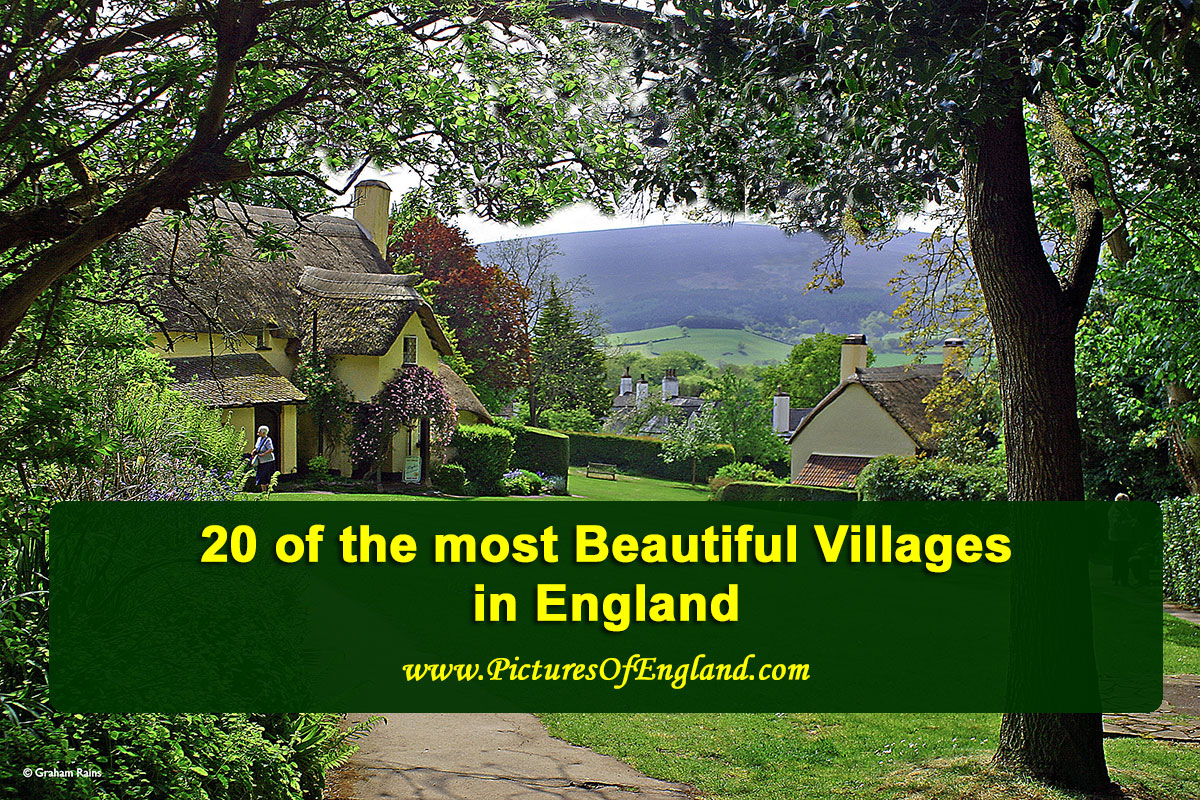
| Article Title | Author | Date |
| The Prettiest Streets in England | poe | 24th November 2020 |
| 10 of the best villages to visit in the Peak District, England | poe | 28th July 2020 |
| A look at some of the most famous views in England... | poe | 16th May 2020 |
| THE TRIAL OF THE PYX | Paul V. A. Johnson | 19th August 2019 |
| The Best Sandy Beaches in Dorset | poe | 7th June 2016 |
| 20 Of The Best Market Towns In England | poe | 1st June 2016 |
| A Human Heart and a Ghost Story in a Northamptonshire Church | Charles Moorhen | 30th October 2009 |
| Exploring the English Village Churchyard | Charles Moorhen | 29th October 2009 |
| Local Legends - The Basingstoke Burial | poe | 28th February 2008 |
| The Hidden Churches of Somerset | Louise Simmons | 6th February 2008 |